As a guitarist, there’s nothing more frustrating than when you’ve tried to fix your guitar intonation, but it’s still too sharp. Whether it’s on just one string or across them all, it can really ruin the sound of your playing.
I’ve been playing and maintaining my guitars for over 15 years, so I put together 10 tried and tested solutions for you to get your guitars intonation from being sharp, to being right.
Affiliate disclaimer: This page contains affiliate links for products that I’ve tried and tested. As an Amazon Associate I earn from qualifying purchases at no additional cost to you. Learn more here.
Equipment needed
Before getting started, you’re going to need the following equipment:
- New guitar strings
- A guitar set-up kit (including precision ruler (measure to 1/32nd”), a capo, and feeler gauges
- A hex key (one should have come with your guitar – if not, a quick Google will give you the right size for your truss rod nut)
- A guitar tuner
If you don’t have these, I’ve linked the gear that I use:
- D’Addario electric guitar strings (Amazon)
- CruzTools Stagehand Compact Tech Kit (GTSH1) (Amazon)
- Boss TU-3 Chromatic Tuner (Amazon)
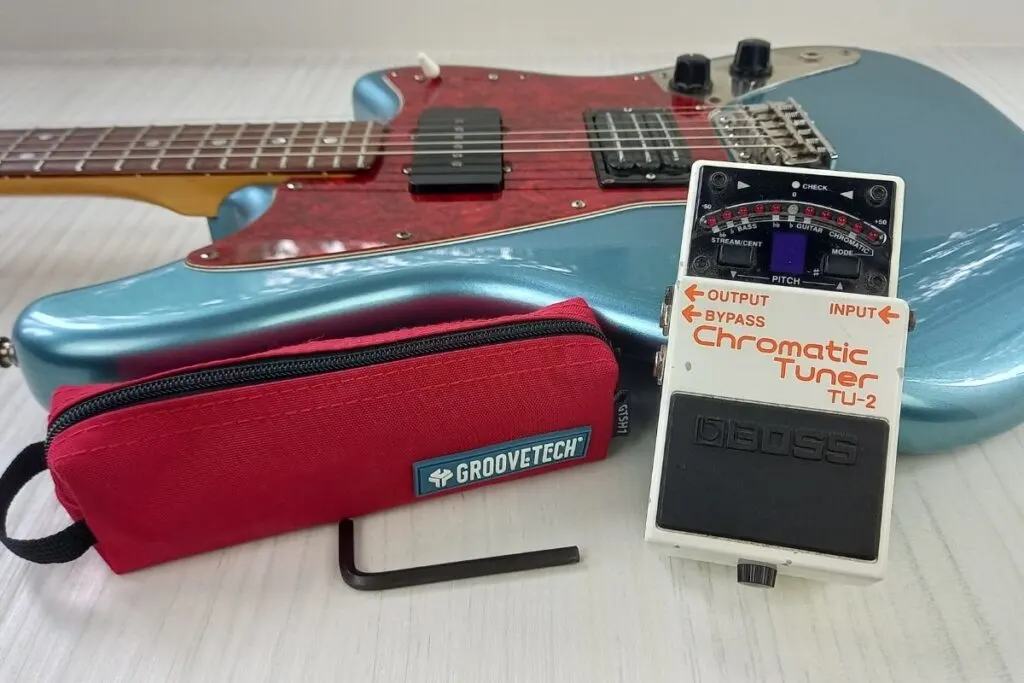
Solution 1: Replace your old guitar strings
Before you start prodding, poking, and adjusting your guitar – the first thing I recommend doing is replacing your old guitar strings with a brand new set. Old guitar strings are, more often than not, the most common cause of sharp and flat intonation.
This is because old strings lose their tension over time, as well as their sound quality as they become damaged and coated in dirt and grime. All these factors can cause your guitar to fall out of tune as you move across the fretboard.
I’ve use D’Addario guitar strings on most of my electric guitar’s, and highly recommend them. You can check them out here on Amazon.
Remember that if you use old strings while adjusting your guitar, you’ll just have to adjust everything again when you replace your old strings with new ones.
Solution 2: Try different gauge guitar strings
If your strings are brand new and still have a sharp intonation, it’s worth checking whether a thicker string (called a “heavier gauge”) could solve the issue.
Lighter gauge strings tend to lose their tuning and can quickly mess with your intonation, especially for more affordable guitars.
Typically, beginner guitarists will use a light gauge (a set of 7s or 8s). Try using a set of 9s or 10s to see if this fixes the problem. You may think these will be too heavy, but your fingers will quickly become stronger, and your ears will thank you.
Again, D’Addario strings have a wide range of gauges available that you can find here on Amazon. I use the 11s, which might be a bit much for some. So, try starting with 9s or 10s.
Solution 3: Apply less pressure when fretting notes
Your technique is another factor that could play a role in your intonation being off.
Beginners typically push too hard when pressing down on the strings – I know because I used to do it myself!
Get out a guitar tuner and test this out yourself. I use the Boss TU-2 Chromatic Tuner as I find it to be easy to use and very precise. You can check it out here on Amazon.
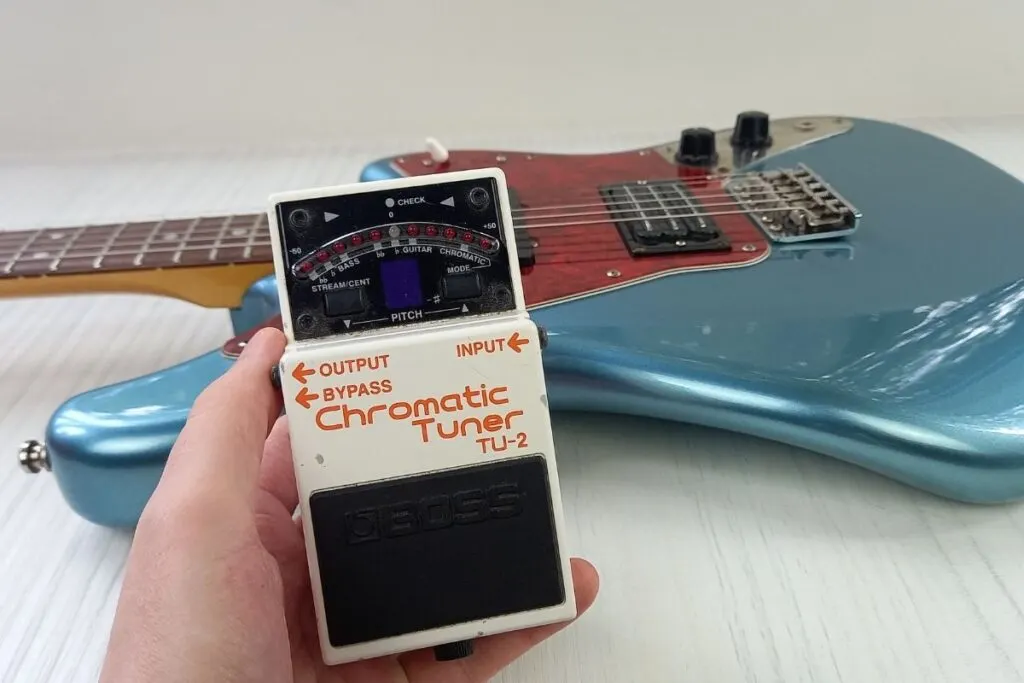
Make sure the strings are in tune, and then when you test the intonation at the 12th fret, try varying degrees of pressure, and you will see the strings tuning will slightly change.
If you are pressing too hard when you play, causing the intonation to go out, the only remedy is to practice playing and improve your technique.
Eventually, you will barely push down at all when playing, making it easier on your hands and your ears! (The adjustments to your guitar’s action later on will help with this!)
Solution 4: Place your finger in the middle of the fret
Another technique-based factor that can cause sharp intonation is playing at fret at the incorrect position.
Always make sure that you push down in the center of the fret when you fret a string.
Again, try this out by plugging in your tuner and playing a note with your finger far back on the fret – the further back you go, the sharper it gets.
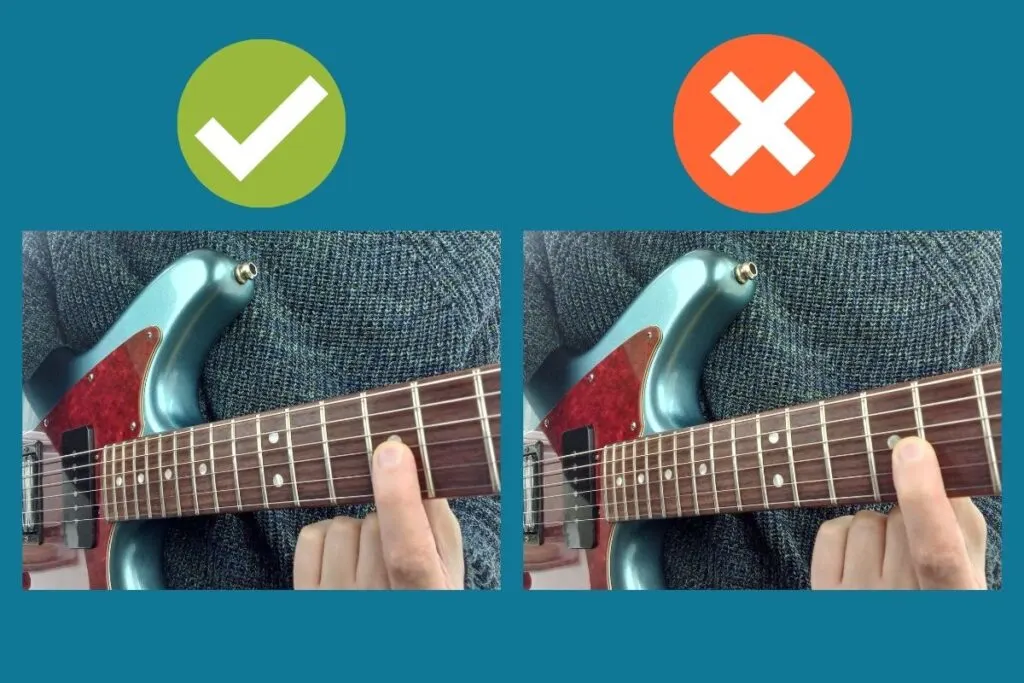
As with pushing down too hard on a fret, the only fix is practicing and perfecting your technique.
When checking your guitar tuning and intonation, make sure you are mindful of your technique and not push too hard or place your finger in the incorrect position.
Solution 5: Lower your pickups
In some situations, you may find that your guitar pickups are causing sharp intonation. It will help if you remember that pickups are literally magnets, and if they are set too high, they can pull notes sharp when they are vibrating.
Strings are made of steel and nickel and are susceptible to magnets, so in this case, you will need to lower your pickups.
Most guitars have a screw on either side, allowing you to raise or lower them. In this situation, adjust them accordingly. You only want to adjust them slightly because they will affect the sound produced depending on their distance from the strings.
Ideally, your pickup should be 1/8“ from the string when pressing the string at the fret closest to the body (usually the 22nd or 24th fret).
For adjustments like these I use the CruzTools Stagehand Compact Tech Kit (GTSH1) as it has all the tools I need for regular guitar maintenance, and I’ve been impressed with the quality of them too. You can check it out here on Amazon.
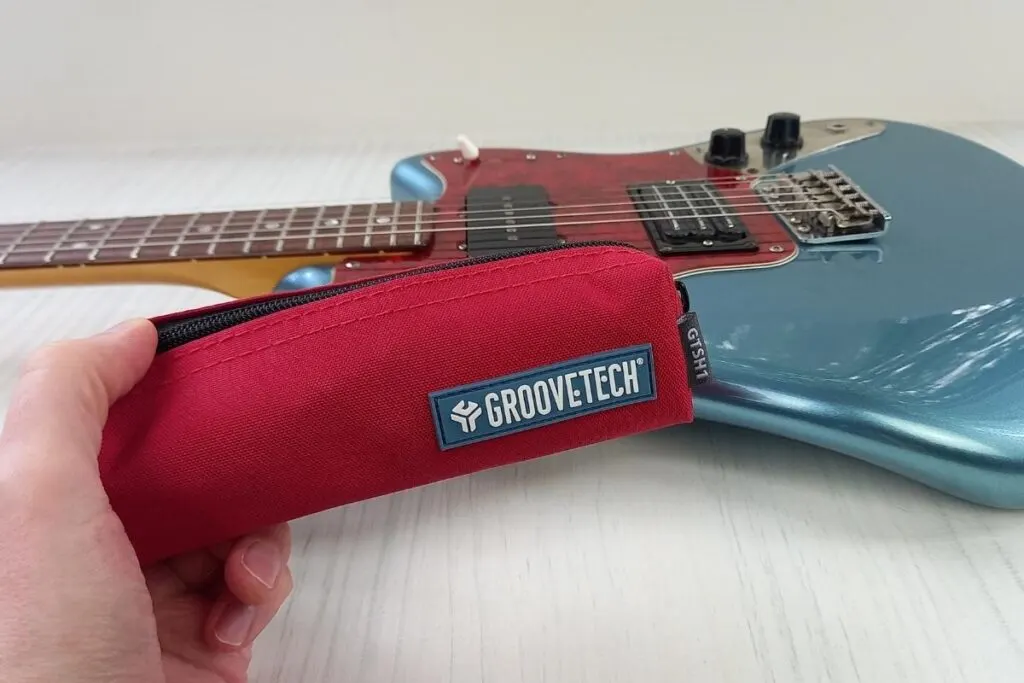
Solution 6: Adjust your guitars saddle
If you’re experiencing a sharp intonation, the first thing people tend to do is adjust the saddles – you might have already tried this, but I recommend double checking this again anyway to remove any doubt.
To adjust your saddle, simply connect your guitar to a tuner and play the open string followed by the 12th fret. The two notes should be the same, as they’re an octave apart.
If the note on the 12th fret is too sharp, then you’ll want to move your saddle closer to your guitar’s bridge.
Depending on your type of saddle, there’ll be a specific method for you to adjust it. The most common saddles are typically ones you can adjust with a screwdriver to lengthen or shorten the saddle.
In this case, you’ll need to turn the screw clockwise to shorten the saddle length (and increase the string length).
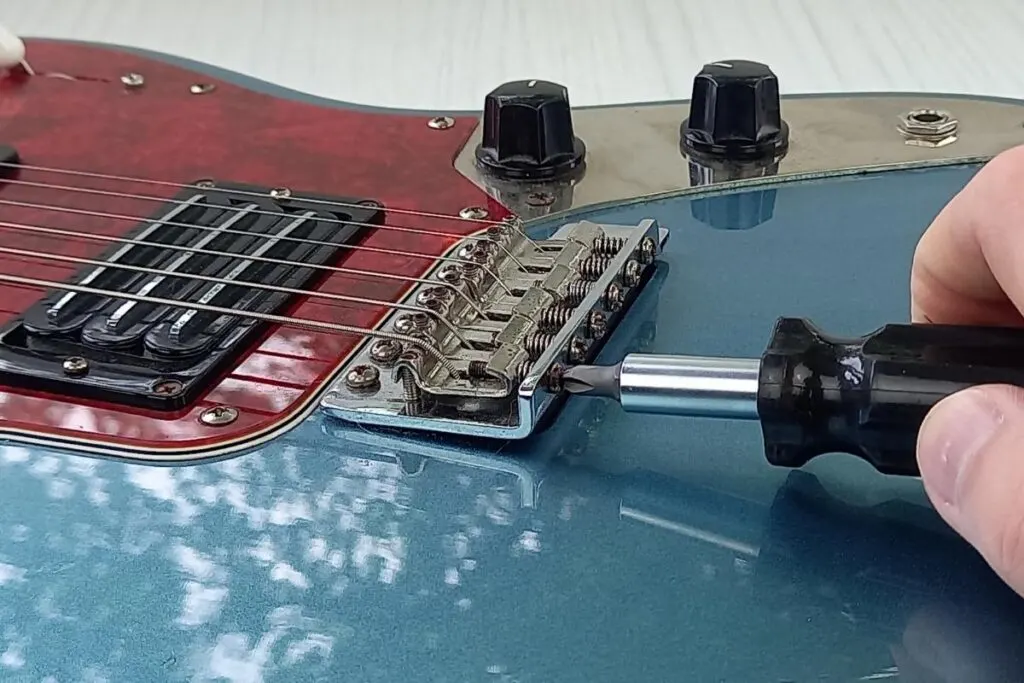
If the saddle is all the way back and the note is still sharp, it’ll likely be that there’s something else wrong with your guitar.
If your guitar has a “Tune-o-Matic” bridge and the intonation is too sharp, and you have set up your guitar correctly, you may need to try and flip the bridge.
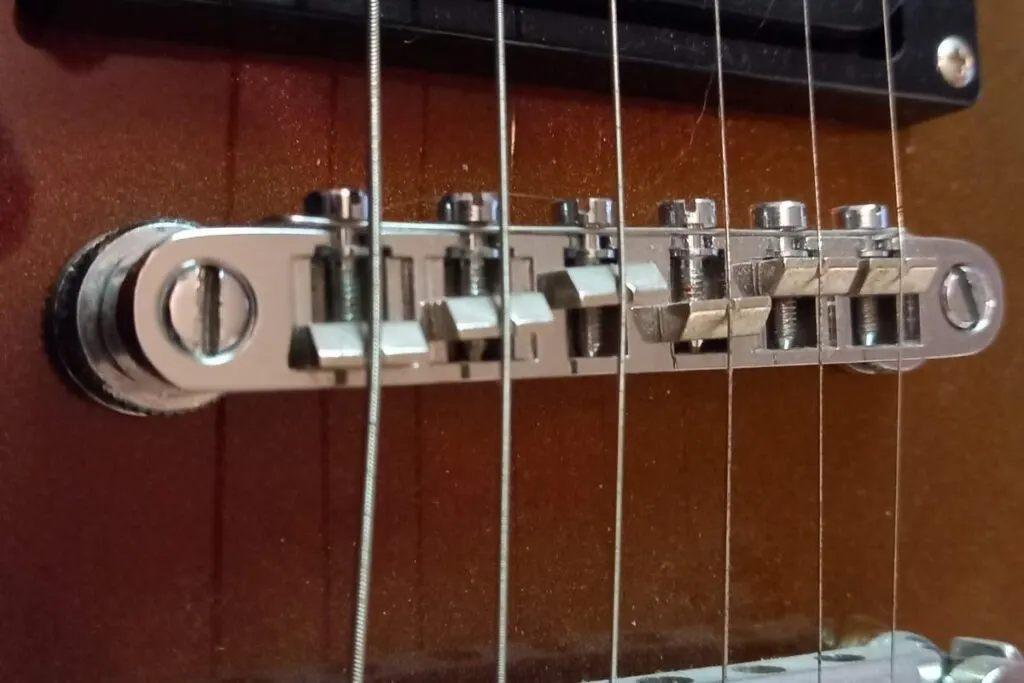
In some cases flipping the bridge will make a difference in the string length. However, if this doesn’t help, keep following these steps for a more permanent solution.
Let’s take a further look to determine what else could be wrong with your intonation if you see that the saddle is all the way back.
Before doing this, I recommend loosening the saddle a little bit, so it’s not all the way back still.
Solution 7: Lower your guitars action
If the problem persists and you have placed new strings and adjusted the saddle, the next thing you should check is the action.
A very high action, where the guitar strings are far away from the fretboard, is another common cause of sharp intonation, as you have to push harder to fret a note.
While Tune-o-Matic bridges typically require a screwdriver to raise or lower the saddle, other more common bridges and saddles will require you to use a small hex key, also called an Allan-key.
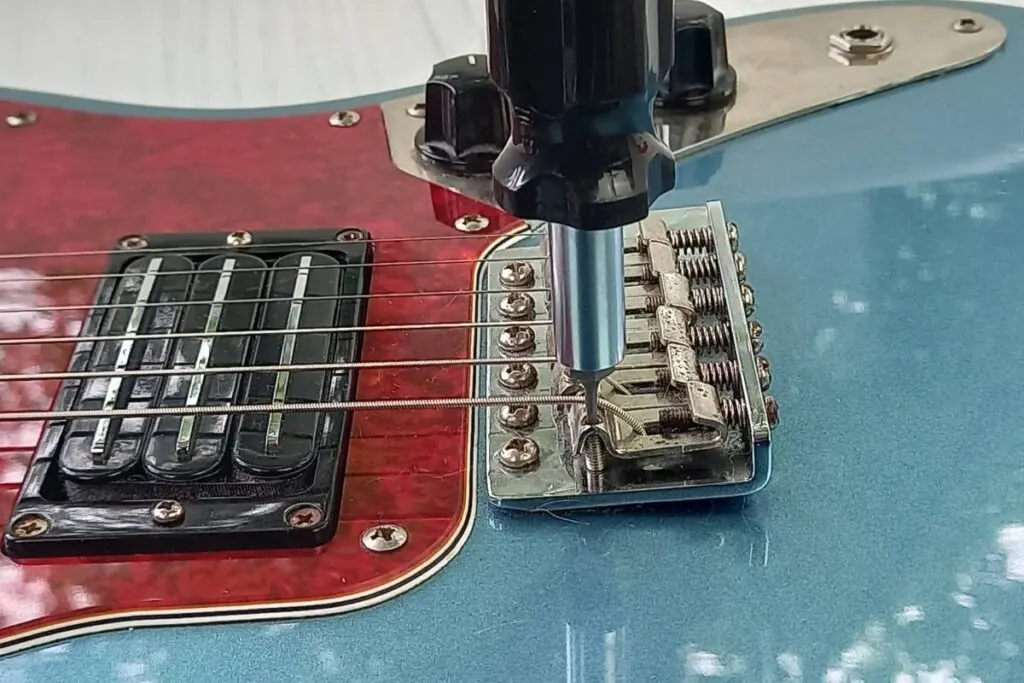
These fender-style bridges will require you to adjust each saddle individually, while the Tune-o-Matic bridges will only need you to adjust each side of the bridge.
Be aware that different fretboards have different shapes, and your action should follow suit.
To set your action, put a capo on the 1st fret. Then measure the distance between the bottom of the string and the 17th fret. It should have a gap of around 5/64” (2mm).
After this adjustment, tune your guitar again and see if this fixes your problem.
Top tip: Be careful not to lower your action too much, otherwise you’ll start getting fret buzz.
Solution 8: Adjust your guitars neck relief
If you’ve tried all the previous fixes and they didn’t work, you may need to change the bow of your guitar’s neck by adjusting the truss rod that runs through the middle of the neck.
Typically, the truss rod is only used to adjust slight variations in the concave and convex shape of the neck so the strings don’t buzz too much in the lower and higher sections of the fretboard.
If you find that the bow of the neck is too convex or concave, you will have to use a hex key to adjust it. Depending on what type of guitar you have, you can find access to the truss rod at the headstock or the neck base.
Important note: Truss rod adjustments should be small and done with caution. Only make a quarter turn at a time and never force it.
Mishandling the truss rod can cause damage to your bass guitar. If you do not feel comfortable making this adjustment, take your bass to a professional.
To measure the neck relief, put a capo on the 1st fret and press the string down at the highest fret. Then, take a feeler gauge to measure the gap between the fret and the string at the 8th fret.
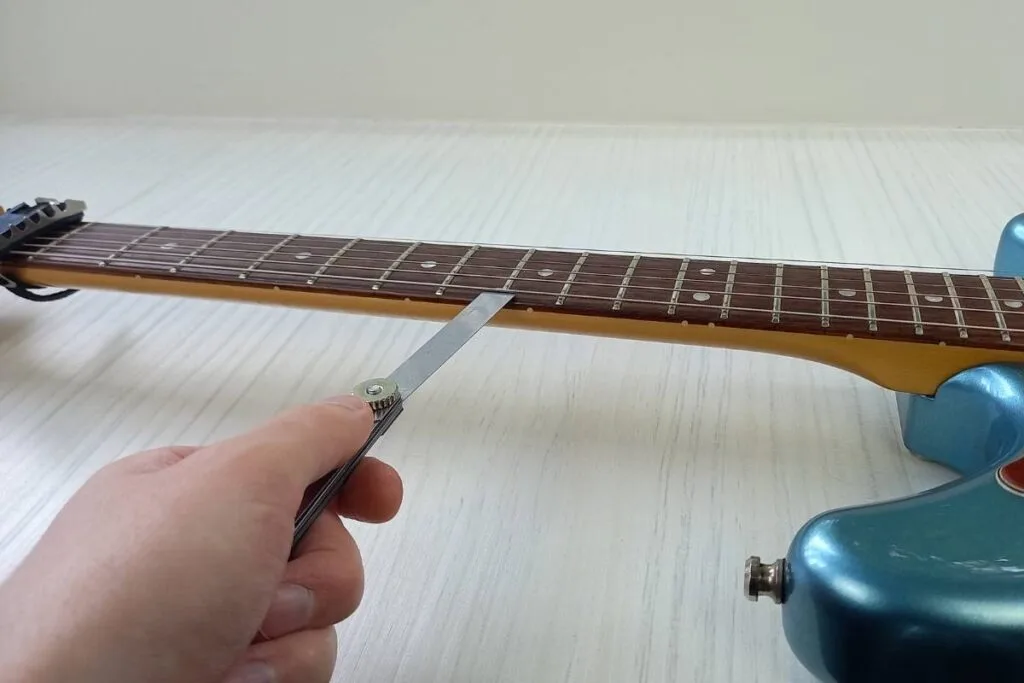
The size of the feeler gauge, and thus ideal neck relief, will depend on your guitar’s fretboard radius.
| Neck Radius (Inches) | Neck Relief at 8th Fret (Inches / Millimetres) |
| 7.25″ | 0.12″ / 0.30mm |
| 9.5″-12″ | 0.10″ / 0.25mm |
| 15″-17″ | 0.08″ / 0.20mm |
You should be able to comfortably pass through the feeler gauge without any excess friction or gap.
If you’ve got too much friction, tighten the truss rod by turning it clockwise. If you’ve got too much gap, loosen the truss rod by turning it counter-clockwise.
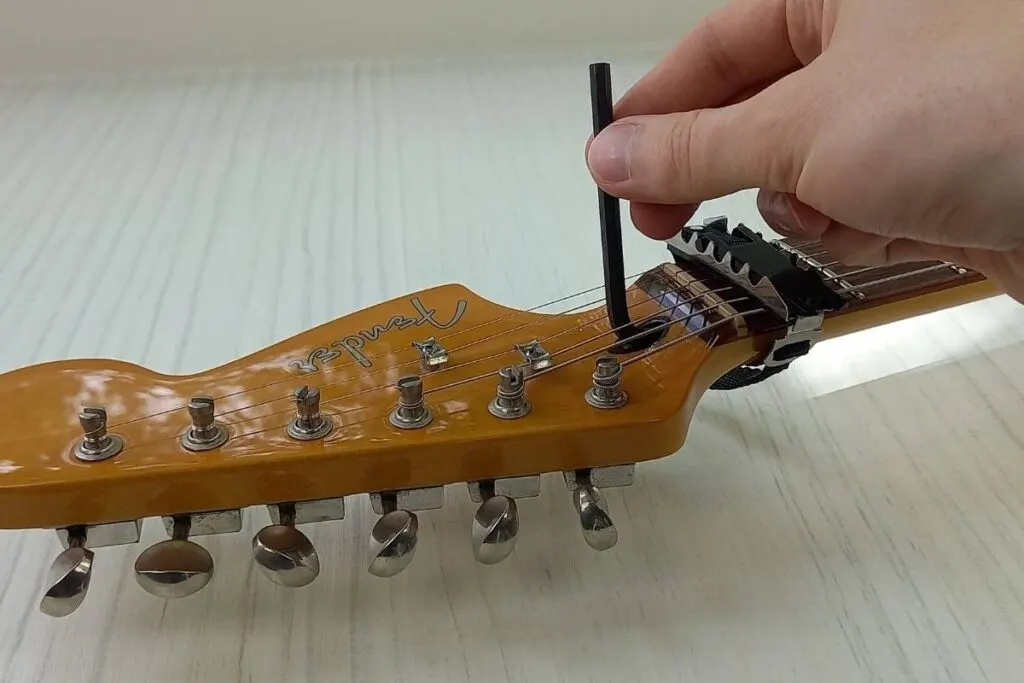
Solution 9: Check for uneven frets
Worn frets or uneven frets are another cause of sharp intonation. This is because flatter frets extend the surface area that the string comes into contact with, which changes its pitch.
The best way to check for uneven frets is to take a fret rocker (or credit card) and lay it across three frets and try to rock it back and forth. If it rocks, one of the frets is uneven.
Repeat this by moving the fret rocker higher up the fretboard, one fret at a time to figure out which of the frets are uneven.
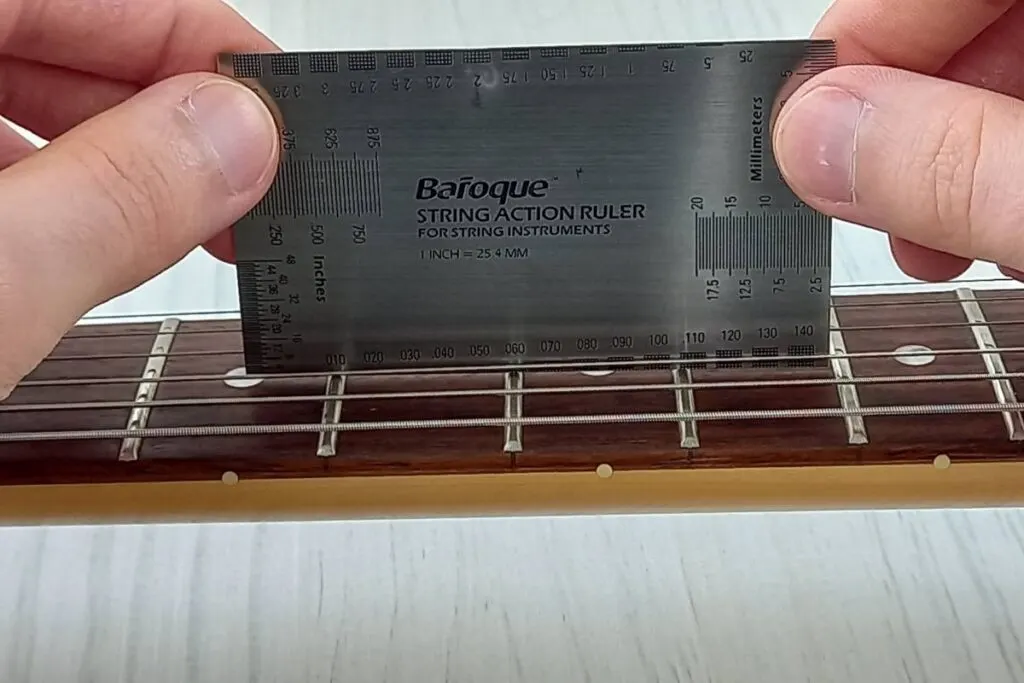
If you find that your frets are worn down, the only fix is either getting them dressed (they are all shaved to the same height) or replacing them.
For this, I recommend taking your guitar to a professional luthier to get them dressed or replaced, because messing with your frets can cause more problems, especially if you’ve never done it before. If done incorrectly, you may even need to replace your neck.
Solution 10: The Guitar Nut Is Too High
The guitar nut on some guitars (especially inexpensive guitars) can sometimes be too high. Thus, the intonation will be sharp no matter what you do.
The only remedy here is to either deepen the string slots or remove the nut and file its underside down. This will put less torque on the string at the nut, which will cause less bending!
However, this is also an adjustment that can cause more harm than good, so I recommend taking your guitar to a professional luthier to get these changes made.


Conor is a music producer, multi-instrumentalist, and all-round enthusiast from the UK with over 15 years of experience. He’s the founder and sole-content creator for the roundtable audio blog and YouTube channel.
